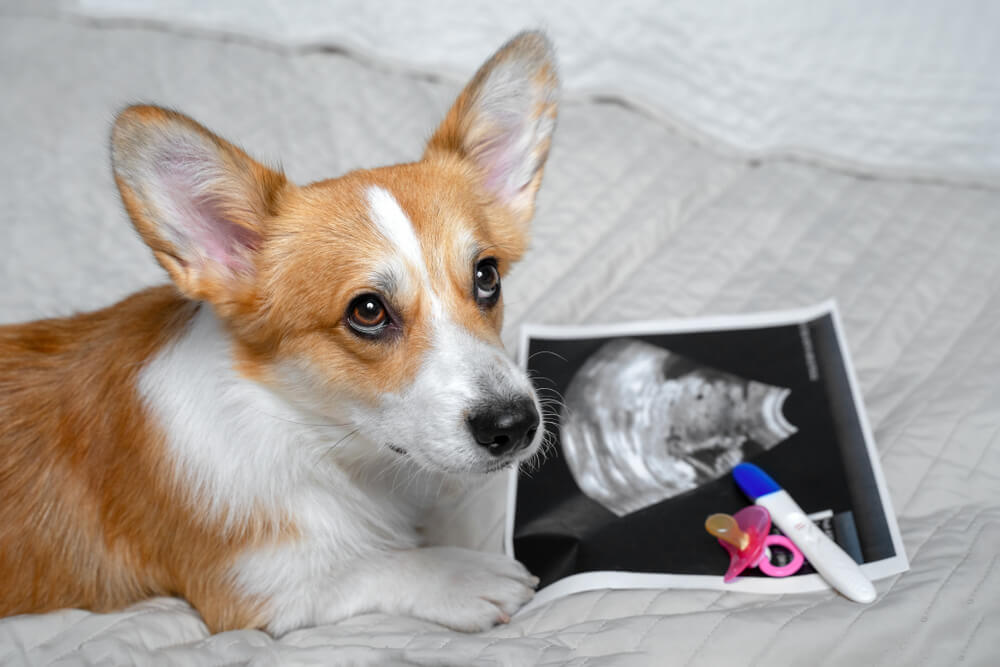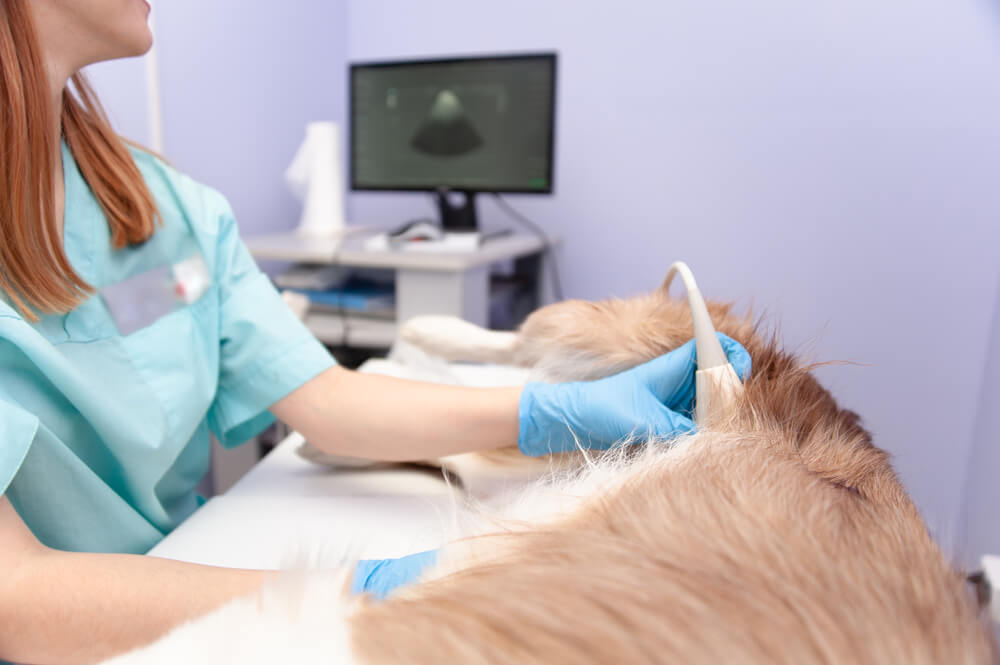How Long Are Dogs Pregnant? What to Know When Your Dog Is Expecting?

Table of Contents
Listen To The Article
Introduction to How Long Are Dogs Pregnant? What to Know When Your Dog Is Expecting?
Welcoming a new litter of puppies into the world is very rewarding, but dog pregnancies can be confusing and stressful, as well as time-consuming and costly.
If you are considering breeding your dog, there is so much information that you need to know.
You should be familiar with your breed’s standard and individual breed health test recommendation, as well as the responsibilities you’ll have in raising healthy well-socialized puppies.
We share many similarities with our canine companions we enjoy many of the same foods, we experience some of the same emotions, and we’re both highly social species.
One area in which dogs are rather different than humans, though, is pregnancy.
For one thing, dogs almost always give birth to more than one offspring at a time, known as their litter of puppies.
And dogs don’t stay pregnant for nearly as long as human mothers do.
Puppies are exciting.
If you are new to breeding, or you are eagerly awaiting the birth of a reserved puppy from a breeder’s litter, the wait can seem eternal.
Luckily for us, the gestation period in dogs is much shorter than the gestation period in humans.
If your female dog is spayed, she can’t reproduce and you’ll never have to worry about your dog’s pregnancy cycle or gestation period.
But if your dog isn’t spayed, or if you’re simply curious, you might want to learn more about pregnancy in dogs.

Your Dog’s Heat Cycle
First, need to understand the dog reproductive cycle.
Intact female dogs go into heat approximately every six months, although this can vary depending on the dog and the breed.
The heat cycle lasts 18-to-21 days and is broken into four distinct stages.
Breeders use these stages to determine the best time to breed their dogs.
The four stages of the female dog’s reproductive cycle are:
- Proestrus
- Estrus
- Diestrus
- Anestrus
Proestrus lasts for about 9 days and is the first stage of the reproductive cycle.
This is when females start to attract males, although they will reject their advances until stage two.
The signs of proestrus are:
- Swelling of the vulva
- Bloody discharge
Estrus lasts anywhere from 3-to-4 days to 7-to-11 days.
This is when the female is receptive to the male.
Many breeders have a veterinarian take vaginal smears and blood tests during proestrus and estrus to make sure they breed their dogs at the optimal time.
The signs of proestrus are:
- A soft and enlarged vulva
- Discharge lightens in color and decreases
Diestrus is the final stage of the cycle.
It typically occurs around day 14.
During diestrus, the bitch’s discharge becomes redder and tapers off, the vulva returns to normal, and she will no longer permit mating.
The heat is complete when all signs of swelling and discharge are gone.
The time frame between one heat cycle and the next is called anestrus and usually lasts around six months.
Understanding the heat cycle plays an important role in determining the length of pregnancy.
Breeders can calculate conception dates by keeping track of their bitch’s heat cycle and breeding period, which makes it easier for veterinarians to accurately test for pregnancy.

How Long Are Dogs Pregnant?
The normal gestation period in dogs is approximately 63 days from conception, although this can vary by several days.
While this might seem like a straightforward answer, conception is often hard to determine.
Sperm can live for several days inside the female, and eggs can remain fertile for up to 48 hours, which means the act of mating itself is not an exact measurement of gestation.
This makes it hard to predict the length of pregnancy without the assistance of a veterinarian.
Hormone measurements give a much more exact time frame for gestation.
Many breeders use vaginal smears and blood tests to monitor reproductive hormones during the breeding process.
This helps them determine the best time to breed their bitch, as well as the length of gestation and the potential due date.
Gestation length according to accurate hormone measurements:
56-58 days from the first day of diestrus
64-66 days from the initial rise in progesterone
58-72 days from the first time the bitch allowed breeding
Pregnancy in dogs is relatively short compared to humans, about 9 weeks total, and each day matters.
Knowing the length of the gestation period is important for the health of the pregnant bitch and the puppies and is used to monitor nutrition and veterinary care during pregnancy.

Stages of Dog Pregnancy
The entire pregnancy can be broken down into three stages, corresponding with the three months of pregnancy.
The First Month
In the first step of pregnancy, the male’s sperm travel to the female’s uterine horns and become embedded in the uterine lining around the 16th day.
A few days later, around day 22, the fetuses themselves start to take shape.
As mentioned above, there probably won’t be any major signs that your dog is pregnant during the first weeks of this stage.
By the fourth week, though, you might see some morning sickness symptoms, vaginal discharge, and a loss of appetite and lethargic disposition.
The Second Month
By the second month, the fetuses are growing quickly.
By the time the pregnancy reaches its 45th to 50th day, the puppies will have skeletons and claws, as well as a coat.
A few days later, the pregnant female will begin looking for a nesting spot in which to deliver her new puppies.
In this month, you’ll notice your pup showing signs of pregnancy like:
- Increased appetite and weight gain
- Increased urination
- An enlarged abdomen
- Vaginal discharge
- Changes in behavior, like an increase in affection or withdrawing from contact
The Third Month
The puppies are almost fully developed by the 58th day of pregnancy, and they’ll start to move into the birthing position in the mother’s birth canal in the final days of the pregnancy.
At this stage, the mother will probably become restless, perhaps panting and pacing about, and will experience a loss of appetite.
The body temperature also drops about 12 to 24 hours before labor begins.
It’s a good idea to prepare a whelping box for your dog to deliver her puppies in.
Line a comfortable box or bed with quilts, blankets, or towels to give your pregnant dog a place to nest.
She’ll go to this area when birthing is imminent to prepare for labor.
Once labor hits, your pregnant dog will continue to behave restlessly and refuse to eat.
Vomiting may continue, and clear vaginal discharge may appear.
Then, the puppies will start to be delivered.
Labor itself can last anywhere from a few hours to a full day. It should not last longer than 24 hours, though.
Puppies will appear one at a time, every half hour or so, but should not appear in increments longer than two hours.

How to Tell if a Dog Is Pregnant?
Humans have developed instantaneous pregnancy tests that make it easy to determine whether or not we are pregnant.
It is not as simple for our dogs.
You will most likely need to visit your veterinarian to find out if your dog is pregnant.
If possible, be sure to tell your vet exactly when your dog was bred, or your best estimate of the time frame, as all of the pregnancy testing methods for dogs, are time-sensitive.
There are four methods veterinarians can use to determine if a dog is pregnant:
- Hormone tests
- Palpation
- X-ray
- Ultrasound
- Hormone Tests
Veterinarians can test for the hormone relaxin to determine if a bitch is pregnant.
Relaxin is released from placental tissue only during pregnancy, which makes it a fairly accurate diagnostic test.
However, the bitch must be at least 30 days into her gestation for the test to be accurate.
Tests taken before that can have a false negative.
Palpation
Palpation is the cheapest and most convenient way to diagnose pregnancy.
As each fetus develops, the membranes around them grow to form fluid-filled sacs.
These sacs can be felt between days 21 and 35 of gestation (approximately three-to-four weeks), and grow to about the size of a table tennis ball in a 45-pound dog.
After one month, the sacs lose their distinctive shape, and the uterus develops a floppy feel that can be mistaken for fat or a pyometra.
X-ray
An x-ray is a great way for breeders to determine how many puppies to expect from their bitch. X-rays are most effective later in pregnancy, as the fetal skull and spine don’t become visible on an x-ray until days 42 through 45.
Waiting until after day 55 allows veterinarians to give an accurate count of the number of expected puppies and to determine the best timing for an elective cesarean.
Ultrasound
An ultrasound is the best way to find out if a dog is pregnant early on in gestation.
Veterinarians recommend ultrasounds between days 25 and 35 of gestation.
Ultrasounds not only detect pregnancy but also determine whether the fetus is alive by registering fetal heartbeats.
Ultrasounds can also be used to rule out other causes of uterine distension, like pyometra, and can help calculate the gestational age of the fetus.

Signs of Dog Pregnancy
Diagnostic testing isn’t the only way to determine whether a dog is pregnant, although it is the most accurate.
There are signs of dog pregnancy you can watch for, including:
- Increase in appetite
- Weight gain
- Increase in nipple size
- Swollen belly
- Tires more easily
- Nesting behavior
- More affectionate
- Irritability
In addition, some dogs may vomit and have a decrease in appetite for a few days in the first few weeks due to changes in hormones.
Some dogs will exhibit these sighs, but may actually be experiencing a false pregnancy.
There are also other conditions that can cause changes in appetite, weight gain, and a swollen abdomen.
To rule out a more serious condition, take your dog to the veterinarian for a checkup.

Caring for a Pregnant Dog
Once you have determined that your dog is pregnant, there are some steps you should take to make sure she stays healthy throughout her pregnancy.
Proper Nutrition
One of the most important things you can do for your pregnant bitch is make sure she receives proper nutrition.
If your dog is already on good quality dog food and is at a healthy weight, you won’t have to make any changes to her diet for the first two-thirds of her pregnancy unless otherwise directed by your veterinarian.
In fact, increasing the amount of food at this stage can be harmful.
As her weight increases in the last weeks of her pregnancy, veterinarians recommend increasing her food intake gradually, until she consumes 35-to-50 percent more than usual.
Increase her intake slowly and feed her small, frequent meals, as large meals can cause discomfort.
Exercise
If you’re trying to breed your dog, some veterinarians believe that limiting strenuous exercise during the first two weeks of gestation will enhance the implantation of the embryos.
After that, normal exercise is fine until your dog’s belly is enlarged.
During her last trimester, the best exercise for your dog should not be overly strenuous.
Shorter and possibly more frequent walks will be more beneficial for the mother to be as she needs her energy to carry the pups and give them nutrition.

Visits to the Vet
Before you breed your dog, take her to the vet for a prenatal checkup.
She should be up-to-date on vaccinations.
Your vet will probably recommend either a fecal exam to check for intestinal parasites or just have your dog dewormed with an appropriate medication suited for your dog prior to mating.
It is now thought that de-worming the pregnant dam with an appropriate dewormer (Fenbendazole) starting on her third trimester (about day 40 of gestation) and continuing under about 14 days post whelping significantly decreases the amount of roundworm and hookworms in newborn puppies, allowing them to grow and thrive to their utmost.
You should also ask your veterinarian what to do in the event of an emergency near the time of expected labor and set up a plan with your family and pet sitter.
Regular veterinary visits can help your dog stay healthy during pregnancy.
When the veterinarian confirms your dog’s pregnancy, they will also examine the dog for any mechanical or anatomical concerns your dog may have that could prevent them from having a normal whelped litter.
This is a good time to discuss planning on whether a normal birth or cesarean may need to be considered and scheduled in advance.
If during the exam your veterinarian determines that your dog is already pregnant, and if the pregnancy is an accident, this is also a good time to discuss taking precautions in the future, such as spaying, to prevent any more surprise litters.

Preparing for Puppies
As the end of your dog’s pregnancy approaches, you’ll notice a significant enlargement of her breasts and nipples and might even detect some milky fluid as the milk glands develop and enlarge.
Her abdomen will increase in size and may sway a little as she walks.
At the very end of the pregnancy, you might even be able to see or feel the puppies moving around inside the mother.
By this time, you want to prepare yourself and your dog for whelping, or puppy birthing.
The best way to do this is to set up a whelping box.
Whelping boxes offer a safe, warm, draft-free, easily cleaned location for your dog to have her puppies.
There are whelping boxes made that can be purchased or you can even use a small children’s plastic swimming pool.
The whelping box should be easy for the mother, but not the puppies, to get in and out of.
Your dog may prefer to have it in a quiet area of the house but in an area that you can have easy access to.
Once you have purchased or built your whelping box, take some time to get your dog accustomed to it.
If you don’t introduce her to the whelping box beforehand, she might decide to deliver someplace else like your closet.
If this is your first time breeding your dog, talk to your veterinarian about your role during labor, and read and learn what you need to know.
Unless you plan to have an experienced breeder on hand, you will need to be prepared to step in when necessary during the whelping process.
It’s always a good idea to have another person there with you to help keep the puppies warm or to assist if you need help.



